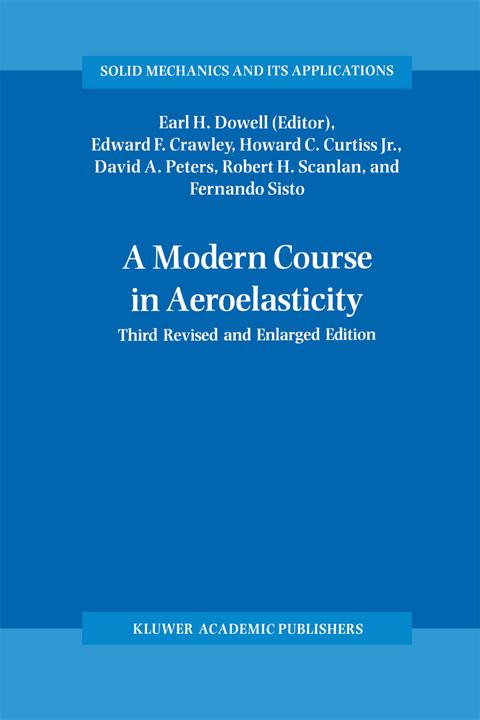
A Modern Course in Aeroelasticity
Springer (Verlag)
978-0-7923-2789-9 (ISBN)
The authors are drawn from a range of fields including aerospace engineering, civil engineering, mechanical engineering, rotorcraft and turbomachinery. Each author is a leading expert in the subject of his chapter and has many years of experience in consulting, research and teaching.
2. Static aeroelasticity.- 2.1 Typical section model of an airfoil.- 2.2 One dimensional aeroelastic model of airfoils.- 2.3 Rolling of a straight wing.- 2.4 Two dimensional aeroelastic model of lifting surfaces.- 2.5 Nonairfoil physical problems.- 2.6 Sweptwing divergence.- 3. Dynamic aeroelasticity.- 3.1 Hamilton’s principle.- 3.2 Lagrange’s equations.- 3.3 Dynamics of the typical section model of an airfoil.- 3.4 Aerodynamic forces for airfoils—an introduction and summary.- 3.5 Solutions to the aeroelastic equations of motion.- 3.6 Representative results and computational considerations.- 3.7 Generalized equations of motion for complex structures.- 3.8 Nonairfoil physical problems.- 4. Nonsteady aerodynamics of lifting and non-lifting surfaces.- 4.1 Basic fluid dynamic equations.- 4.2 Supersonic flow.- 4.3 Subsonic flow.- 4.4 Representative numerical results.- 4.5 Transonic flow.- 5. Stall flutter.- 5.1 Background.- 5.2 Analytical formulation.- 5.3 Stability and aerodynamic work.- 5.4 Bending stall flutter.- 5.5 Nonlinear mechanics description.- 5.6 Torsional stall flutter.- 5.7 General comments.- 5.8 Reduced order models.- 5.9 Computational stalled flow.- 6. Aeroelastic problems of civil engineering structures.- 6.1 Vortex shedding.- 6.2 Galloping.- 6.3 Divergence.- 6.4 Flutter and buffeting.- 7. Aeroelastic response of rotorcraft.- 7.1 Blade dynamics.- 7.2 Stall flutter.- 7.3 Rotor-body coupling.- 7.4 Unsteady aerodynamics.- 8. Aeroelasticity in turbomachines.- 8.1 Aeroelastic environment in turbomachines.- 8.2 The compressor performance map.- 8.3 Blade mode shapes and materials of construction.- 8.4 Nonsteady potential flow in cascades.- 8.5 Compressible flow.- 8.6 Periodically stalled flow in turbomachines.- 8.7 Stall flutter in turbomachines.- 8.8 Chokingflutter.- 8.9 Aeroelastic eigenvalues.- 8.10 Recent trends.- 9. Unsteady transonic aerodynamics and aeroelasticity.- Summary.- Nomenclature.- 9.1 Introduction.- 9.2 Linear / nonlinear behavior in unsteady transonic aerodynamics.- 9.3 Viable alternative solution procedures to finite difference methods.- 9.4 Nonuniqueness.- 9.5 Effective, efficient computational approaches for determining aeroelastic response.- 9.6 Nonlinear flutter analysis in the frequency domain.- 9.7 Concluding remarks.- 10. Experimental aeroelasticity.- 10.1 Review of structural dynamics experiments.- 10.2 Wind tunnel experiments.- 10.3 Flight experiments.- 10.4 The role of experimentation and theory in design.- 11. Nonlinear aeroelasticity.- Abstract.- 11.1 Introduction.- 11.2 The physical domain of nonlinear aeroelasticity.- 11.3 The mathematical consequences of nonlinearity.- 11.4 Representative results.- 11.5 The future.- 12. Aeroelastic control.- 12.1 Objectives and elements of aeroelastic control.- 12.2 Modeling for aeroelastic control.- 12.3 Control modeling of the typical section.- 12.4 Control design for the typical section.- Appendix I A primer for structural response to random pressure fluctuations.- References for Appendix I.- Appendix II Some example problems.
| Erscheint lt. Verlag | 30.6.1995 |
|---|---|
| Reihe/Serie | Solid Mechanics and Its Applications ; 32 |
| Zusatzinfo | XXIII, 704 p. |
| Verlagsort | Dordrecht |
| Sprache | englisch |
| Maße | 160 x 240 mm |
| Themenwelt | Naturwissenschaften ► Physik / Astronomie ► Mechanik |
| Technik ► Fahrzeugbau / Schiffbau | |
| Technik ► Luft- / Raumfahrttechnik | |
| Technik ► Maschinenbau | |
| ISBN-10 | 0-7923-2789-6 / 0792327896 |
| ISBN-13 | 978-0-7923-2789-9 / 9780792327899 |
| Zustand | Neuware |
| Haben Sie eine Frage zum Produkt? |
aus dem Bereich


